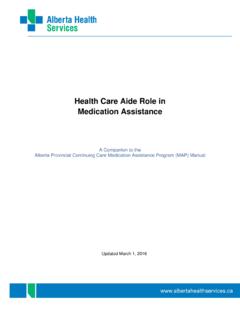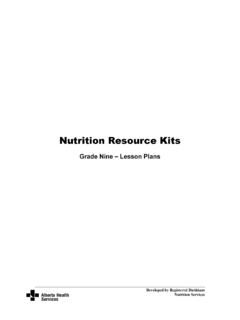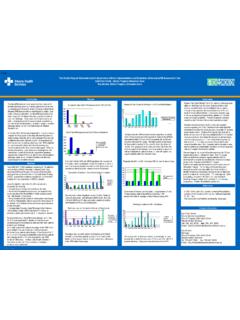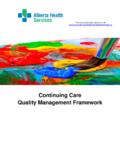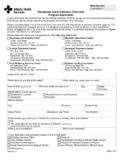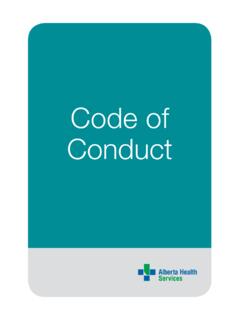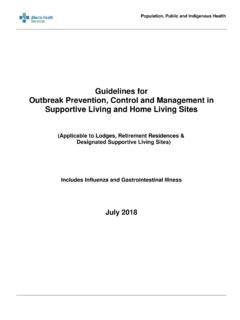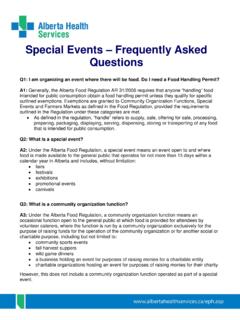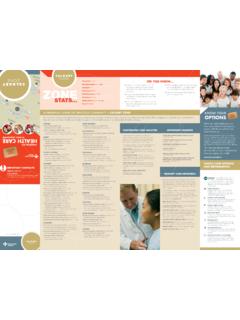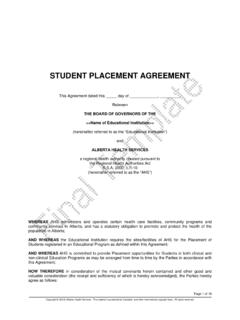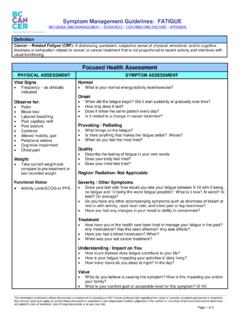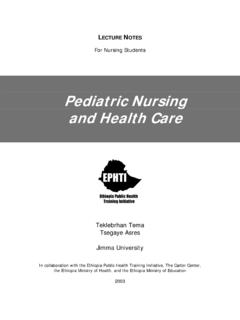Transcription of Helicobacter pylori (H. pylori) Primary Care Pathway
1 3. Diagnosis Test using HpSAT or UBT Before testing, patient must be off antibiotics for 4 weeksand off PPIs at least 3 daysHelicobacter pylori (H. pylori ) Primary Care PathwayNoNegativePositive4. Treatment (for patients not allergic to penicillin) First Line: CLAMET Quad (PAMC) or BMT Quad (PBMT) Second Line (if needed): CLAMET Quad (PMAC) or BMT Quad (PMBT) Third Line (if needed): Levo-Amox (PAL) Fourth Line (if needed): Rif-Amox (PAR) or refer to GI*See expanded details for patients allergic to penicillin/amoxicillin6. Treatment failure Proceed to next line of treatment Option to refer to GI after 3 failed treatment attempts5. Confirm eradication HpSAT or UBT at least 4 weeks after finishing treatment Before testing, patient must be off antibiotics for 4 weeksand off PPIs at least 3 daysOrPathway carecompleteSymptomspersist Patients with dyspepsia symptoms Patients with current or past gastric or duodenal ulcers or upper GI bleed Patients with personal or first-dgree relative with history of gastric cancer First generation immigrants from Asia, Africa, and Central and South America2.
2 Alarm featuresDyspepsia symptoms or H. pylori diagnosis, plus one or more of following: Family history (first-degree relative) of esophageal or gastric cancer Personal history of peptic ulcer disease Age > 60 with new and persistent symptoms (> 3 months) Unintended weight loss (> 5% over 6-12 months) Progressive dysphagia Persistent vomiting (not associated with cannabis use) Black stool or blood in vomit (see Primer on Black Stool). If yes, do CBC,INR, & BUN as part of referral. iron deficiency anemia (see iron Primer)NoYe sNoYe sFollowDyspepsia pathwayYe sUpdated: October 2021 Page 1 of 16 Local resourcesQuicklinks:Expanded detailsAdvice optionsPatient pathwayPathway primerBackgroundProvider resourcesPatient resourcesPre-referral checklist7. Refer forconsultation/endoscopyIf unsatisfactory response, consider using an advice service before referring1.
3 Who should be tested for H. pylori ?Last Updated: October 2021 Page 2 of 16 Back to Algorithm This Primary care Pathway was co-developed by Primary and specialty care and includes input from multidisciplinary teams. It is intended to be used in conjunction with specialty advice services, when required, to support care within the medical home. Wide adoption of Primary care pathways can facilitate timely, evidence-based support to physicians and their teams who care for patients with common low-risk GI conditions and improve appropriate access to specialty care, when needed. To learn more about Primary care pathways, check out this short video. Helicobacter pylori (H. pylori ) PRIMER Overall prevalence in Canada is about 20-30%, depending on age.
4 Prevalence is considerably higher in First Nations communities and in immigrants from developing countries in South America, Africa, and Asia. Prevalence of antibiotic resistant strains of H. pylori is higher in certain immigrant populations (Southeast Asia, Africa, Central America, and South America). Infection most commonly occurs during childhood. About 5-15% of patients with H. pylori will develop duodenal or gastric ulcers. This is higher in patients who chronically use nonsteroidal anti-inflammatory drugs (NSAIDs), including low-dose aspirin. H. pylori increases the risk of gastric adenocarcinoma and MALT lymphoma, but overall the lifetime risk of this is very low at < 1%. There is an increased risk of gastric cancer among First Nations people and immigrants from developing countries such as South America and Asia.
5 For an overview of how to use this Pathway to diagnosis and treat H. pylori , watch the following short video: How the Pathway Changed my Practice. EXPANDED DETAILS 1. Who should be tested for H. pylori ? Patients with dyspepsia, characterized by epigastric pain or discomfort that may be triggered by eating and may be accompanied by a sense of abdominal distention or bloating , early satiety, or loss of appetite. o For patients with dyspepsia symptoms, testing for H. pylori may be completed prior to trial of proton pump inhibitor (PPI) or after PPI treatment. o See Dyspepsia Pathway . Patients with current or past gastric or duodenal ulcers or upper GI bleed. Patients who have a personal or first-degree relative with history of gastric cancer should be considered for testing once in adulthood.
6 First generation immigrants from high prevalence areas (Asia, Africa, Central America, and South America). NOTE: many H. pylori infected patients are asymptomatic. Most studies suggest that H. pylori does not play a role in gastro-esophageal reflux disease (GERD) and patients are understandably disappointed when their GERD does not improve after eradication of H. pylori . o See GERD Pathway . 2. Alarm features If any of the following alarm features are identified, refer for consultation/endoscopy. Include any and all identified alarm features in the referral to ensure appropriate triage. Dyspepsia symptoms or H. pylori diagnosis, accompanied by one or more of the following: o Family history (first degree relative) of esophageal or gastric cancer For these patients, it is appropriate to test for H.
7 pylori while they are waiting for consultation/gastroscopy and to initiate treatment if there is a positive result o Personal history of peptic ulcer disease Last Updated: October 2021 Page 3 of 16 Back to Algorithm o Age > 60 with new and persistent symptoms (> 3 months)1 o Unintended weight loss (> 5% over 6-12 months) o Progressive dysphagia o Persistent vomiting (not associated with cannabis use) o Black stool or blood in vomit (see Primer on Black Stool). If yes, do CBC, INR, and BUN as part of referral. o iron deficiency anemia (see iron Primer) 3. Diagnosis Depending on local availability, test with the H. pylori Stool Antigen Test (HpSAT) or the Urea Breath Test (UBT). o HpSAT is the Primary test for H. pylori in the Edmonton, Calgary, and South Zones, as well as selected sites in the North and Central Zones.
8 False positive results with both UBT and HpSAT are rare, but false negatives may result from recent use of antibiotics or anti-secretory drugs (PPI or H2-receptor antagonists). Accurate test results depend on proper preparation: o Patients should be off antibiotics for at least 4 weeks before the test. o Patients should not take bismuth preparations ( Pepto Bismol) for 2 weeks before the test. o Patients should be off PPIs at least 3 days before the test, but preferably this should be 2 weeks. o Patients with symptoms may take antacids up to 24 hours before their test. Patient preparation instructions can be found at the following links: o DynaLIFE (HpSAT) o DynaLIFE (UBT) o Alberta Precision Laboratories (HpSAT) o Alberta Precision Laboratories (UBT) 4.
9 Treatment Standard triple therapy regimens (PAC (PPI + clarithromycin + amoxicillin), PMC (PPI + metronidazole + clarithromycin), and PAM (PPI + amoxicillin + metronidazole)) are no longer recommended due to changing Pregnant and nursing women should not be treated for H. pylori . Patient handouts are available for each treatment regimen To determine the appropriate treatment regimen for children with H. pylori infection, consult a pediatric gastroenterologist through eReferral Advice Request. For all other patients, treat as follows: Table 1: Treatment Regimens Helicobacter pylori treatment regimens for patients NOT ALLERGIC to penicillin* First line CLAMET Quad (PAMC) for 14 days PPI standard dose BID Amoxicillin 1000 mg BID OR Metronidazole 500 mg BID Clarithromycin 500 mg BID BMT Quad (PBMT) for 14 days PPI standard dose BID Bismuth subsalicylate 2 tabs (524 mg) QID Metronidazole 500 mg QID Tetracycline 500 mg QID 1 There is some variation between guidelines about the age at which dyspepsia symptoms are more concerning and warrant stronger consideration of gastroscopy.
10 Choosing W isely Canada now uses age 65. However, age is only one element of a risk assessment related to the need for gastroscopy to investigate dyspepsia symptoms. 2 The Toronto Consensus for the Treatment of Helicobacter pylori Infection in Adults. Last Updated: October 2021 Page 4 of 16 Back to Algorithm Second line (after failing initial treatment) If CLAMET Quad (PAMC) was used as initial treatment, use BMT Quad (PBMT) for second round If BMT Quad (PBMT) was used as initial treatment, use CLAMET Quad (PAMC) or consider Levo- Amox (PAL) Third line (after failing initial and subsequent treatment) Levo-Amox (PAL) for 14 days PPI standard dose BID Amoxicillin 1000mg BID Levofloxacin 500mg daily Fourth line (after failing the 3 options above) If H.
